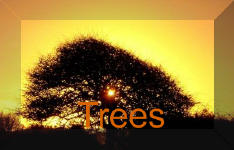BACK TO


Family - Corylaceae
Synyomns
Irish Coll (family - Corylaceae)The latin name Corylus avellana comes from the Greek korys meaning helmet, a reference to the calyx covering the nut; avellana commemorates the town of Avella in Italy where the nuts were cultivated; hazel is from the Old English haesel.
Description:
Hazel is a small deciduous tree, usually with multiple stems and a spreading habit. It is hardy, moderately shade-tolerant and grows best on heavy but well drained soil. frequently coppiced and used for hedges. Many superstitions associated with hazel form Celtic times. Height max 6m. Max age 70-80 yearsAs a tree its maximum life span is about 60 years but when constantly coppiced back it can survive 600 years and still produce a good crop of poles.
Leaves
Flowers
Male and female flowers grow on the same plant - the male catkins open as the first warm days of Spring arrive into bunches of bright yellow, drooping "lamb tails"; female flowers on the same branches appear as tiny pink tufts on plump buds.The fertilised flowers develop into the well known clusters of nuts which turn brown in October.
Location:
Not acid soils. Often found as understorey in oak woodlands.
Natural distribution throughout all of British Isles and Europe, West Asia
and North
Africa.
Phenology:
Flowers Leaves Fruit Ripen Fall
Feb May Aug-Sept Oct November
Catkins very distinctive in February when nothing else in flower or leaf.
Wildlife
Hazel nuts are important for the survival of the native dormouse but the introduced grey squirrel now takes many of the nuts before they ripen.
Uses
White to reddish, tough and flexible. Was extensively coppiced providing long sticks for a variety of uses. Uses of wood - Used in past for cask hoops, basketry, walking sticks, hurdles, thatching, spars and devining rods. Good firewood. Food and drink - Nutritious and tasty nuts taken by large birds and by squirrels and mice that store the nuts. Nuts produced from pruned bushes grown in open conditions like a fruit orchard.
Growth & Propagation
From seed - dispersion aided by animals. Easily grown from nuts kept cool and moist till spring.
Coppicing
Hazel stems split and twist easily to make hurdles,
thatching, liggers, spars, sways and pegs. Hazel is or was used for fencing,
hurdles, barrel hoops, walking sticks, fishing rods, whip handles, ties for
fastening thatch, pegs, fuel for ovens, faggots and charcoal for gunpowder,
domestic fires and ovens.o ensure a steady supply of hazel rods and sticks,
bushes were or are still are coppiced or cut back to ground level about every
7-15 years and new growth springs up from the bases or stools.The management
of hazel coppice and "coppice with standards" is a precise and ancient
science. Traditionally coppice would be cut on a 7-15 year rotation and the
woodland divided into the same number of sections as years in the rotation
so one part of the wood was harvested every year.Coppiced Hazel poles were
woven into panels called wattles, which were used to construct the walls of
houses. Wattles were covered with daub to keep out wind and rain. Daub is
a cocktail of wet clay, dung, chopped straw and lime.Untreated woven panels
were used as hurdles to pen sheep and this art is still alive in lowland Britain.In
folklore, a hazel rod protected against evil spirits and was the best twig
for water divining. In Ireland, it was the tree of knowledge and in medieval
England was a symbol of fertility. Hazel nuts were carried as charms or to
ward off rheumatism in some parts of England.
Links